In the early hours of April 29, 1903 high above the town of Frank, Northwest Territories, (Alberta wasn’t a province until 1905) a massive section of Turtle Mountain, the peak that towers over the town, collapsed, unleashing a devastating avalanche of rock and debris. The slide, which spread debris as far as 3 km away and 120 m up the opposite side of the valley as it crashed down at close to 112km/h, buried a large portion of the town, killing over 70 people and destroying homes, businesses, and a large section of newly built rail line essential to the local mining economy. The Frank Slide is remembered to this day as Canada’s deadliest rockslide.
Today, the Frank Slide is a popular tourist destination in the Crowsnest Pass, and an iconic landmark of the region. Visitors can take a walk along the Frank Slide Interpretive Loop, a unique trail which offers an in-depth look at the disaster and its aftermath. The walk begins at the Frank Slide Interpretive Centre, which houses a number of exhibits and displays that provide background information on the slide and the town of Frank. A visit to the center is a great way to spend some time learning about local history, and is one of the best things to do in the Crowsnest Pass. Hours and ticket prices.
As you make your way along the short and easy trail, you’ll see firsthand the destructive power of the slide. The trail winds through the stark moon-like landscape of rock and debris, offering stunning views of the surrounding mountains. Interestingly, a result of the top of the mountain crashing down into the valley below is that it’s created an environment suitable for the kinds of animals that usually on live on the tops of mountains. It’s unusual to see pikas at such low elevations, but don’t be surprised if you hear their friendly squeaking as you walk along the trail. Along the way, you’ll also see numbered markers which correspond to sections of an interpretive guidebook obtainable from inside the centre. I highly suggest doing so, as learning about the disaster only enhances the experience of walking through it. The short loop through the rubble is the easiest hike you can do in the Crowsnest Pass region, but is by no means the least rewarding. The short and generally wide gravel path is perfect for families or hikers of any fitness level.
Overall, Frank Slide is a unique and fascinating destination that offers a glimpse into one of Alberta’s most tragic events. Whether you’re a history buff or simply looking to learn more about the natural world, a visit to Frank Slide and a walk along the trail is a must-do activity while in the Crowsnest Pass.
Continue reading this blog post for everything you need to know to experience the Frank Slide Trail in the Crowsnest Pass for yourself, including distance, elevation gain, how to get there, the best time to visit, and lots of photos of my experience.
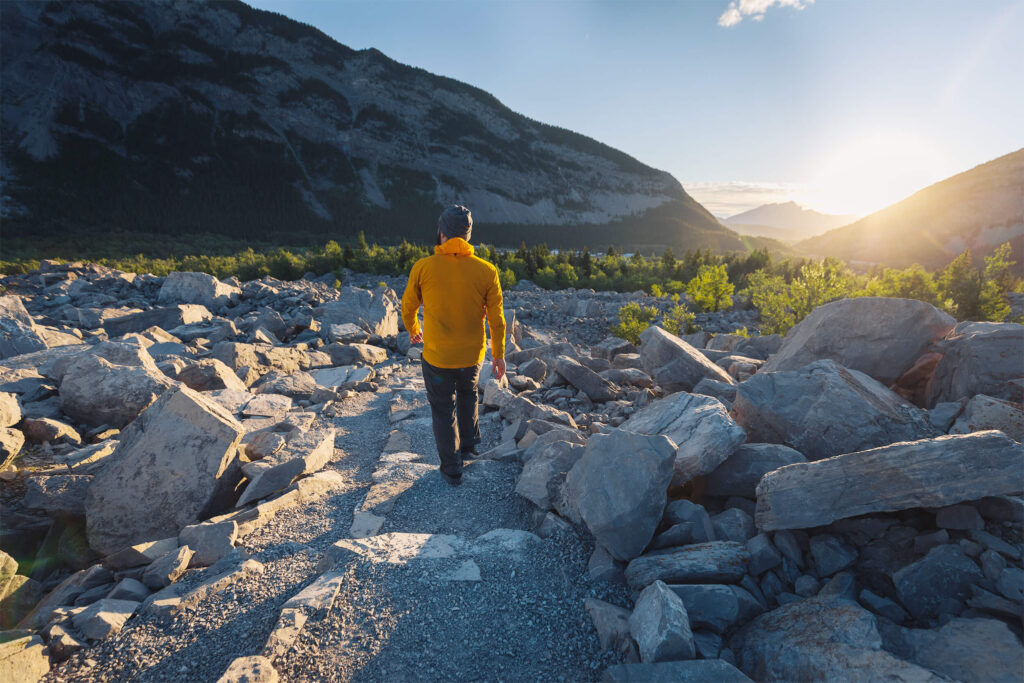
When hiking it’s important to avoid harmful practices such as disturbing plants or rock-stacking, or removing any natural object from flowers to rocks, as it’s important to leave the environment as natural as possible for the animals and for fellow hikers to enjoy in perpetuity. As many flowers as there are, there are few enough that if we all took one, then there wouldn’t be any left. Take only photos, leave only footprints.
If you haven’t heard of Leave No Trace principles, they’re also really essential to read up on before heading anywhere into the outdoors in general. Following these important principles basically means doing your best to leave beautiful places like the Frank Slide Trail as good (if not better) than you found them, both for their preservation and for the enjoyment of other visitors.

Frank Slide Trail Round Trip Details
Distance: 1.6 KM / 1 MI
Elevation Gain: 65 M / 213 FT
Hiking Time: 30 Mins
Hiking & Safety Tips
- Prepare for the possibility of wildlife encounters. Bear spray is a must whenever travelling in bear country, as well as learning how to use it. Though your chance of an aggressive bear encounter is low, it is always better to be prepared with bear spray. Bear bells are proven to be an ineffective bear deterrent, and are actively discouraged by Parks Canada. The best way to let bears know you’re around is simply to use your voice. Make sure to keep a respectful distance from wildlife and never feed the animals. It may seem kind but it doesn’t just kill wildlife and put people in danger, it’s also in many cases illegal.
- Research current trail conditions and make sure you are well-informed about the route before you leave, and assess if it is within your capability. Be aware of what time it gets dark and check the weather forecast. Make sure to tell someone where you’re going and when you expect to return. Every year as more and more people try hiking for the first time, the number of rescues goes up. Being prepared is the best defense.
- Pack everything you need for a successful hike, including enough water and energy-rich snacks. Remember to pack out everything you pack in though – don’t expect to find a convenient garbage can halfway up the trail. Bring appropriate layers (remember you’ll warm up once you start hiking) and sun protection. Hiking poles may be helpful but are not required. In addition to not leaving any garbage on the trail yourself, I highly recommend bringing a garbage bag and collecting any trash that you do see on the trail. You’re guaranteed to make the hike along the Frank Slide Trail a more enjoyable experience for the next person.
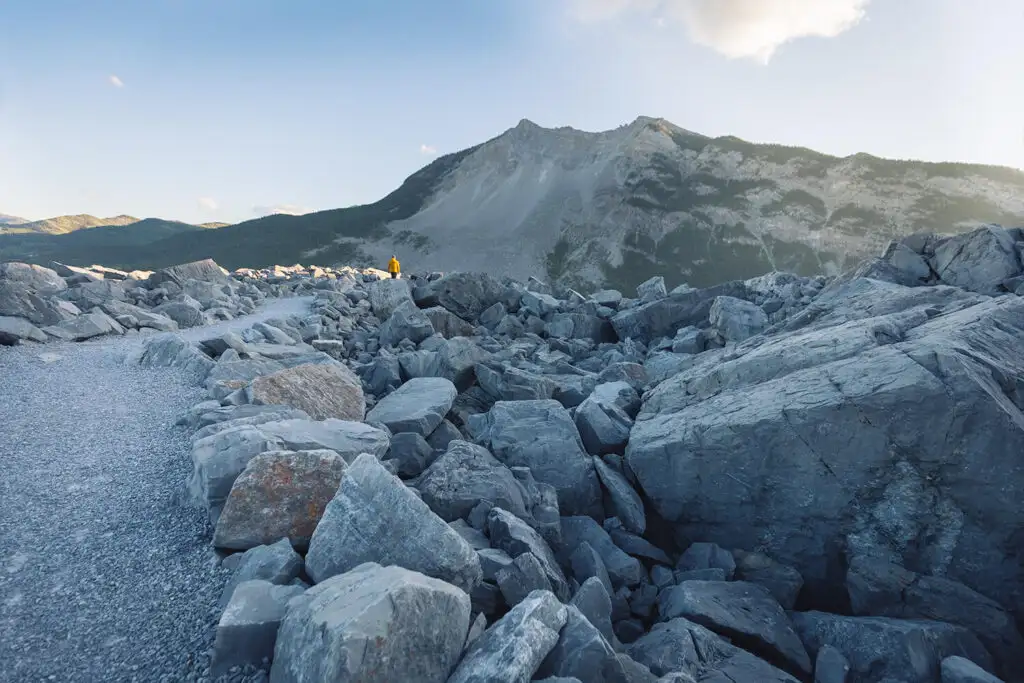
How to Get to Frank Slide Trail Trailhead
If driving from the east, the well-signed turn-off for the Frank Slide Interpretive Center from the Crowsnest Highway is just after driving through the rock slide itself. It’s a bit less obvious if driving from the west, so keep an eye for it just after the A&W. From there the road winds up somewhat steeply to the top of the hill on which the interpretive Center is located. The parking lot is an hour and a half from Lethbridge or two hours from Cranbrook.
Click here to open the exact trailhead location in Google Maps.
Hiking the Frank Slide Trail
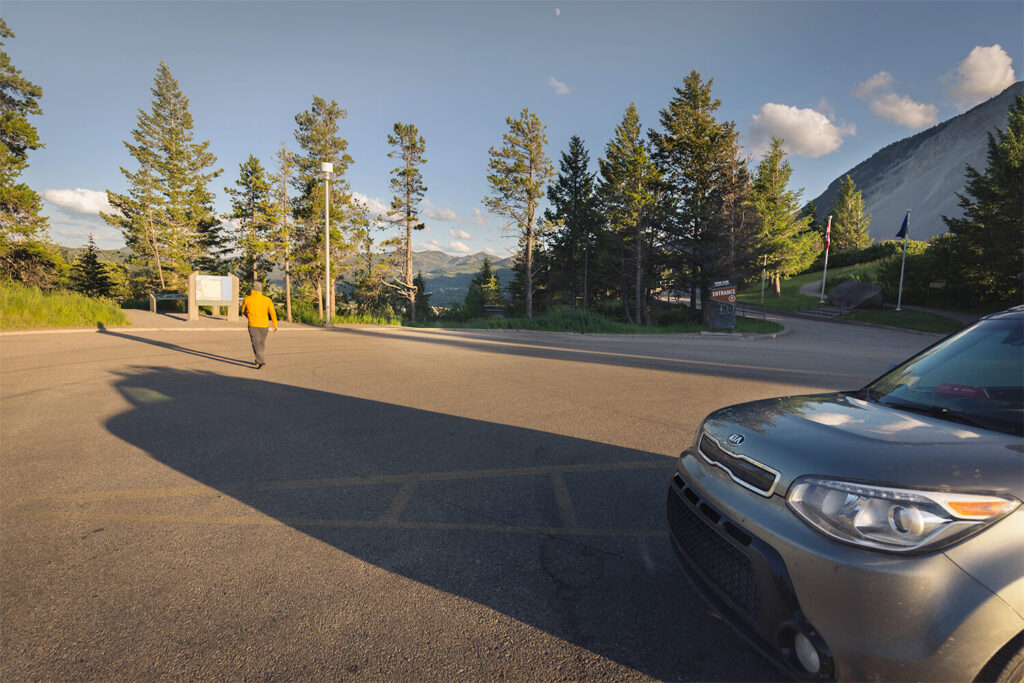
Setting off towards the trail from the parking lot. The short path up to the interpretive center itself is on the right.

The gravel path slowly descends through the rubble.

It’s very easy to disappear into the landscape. Turtle Mountain looks impressive in the distance, especially when you realize just how far the boulders travelled from the top of the mountain.

Flowers make it all okay.
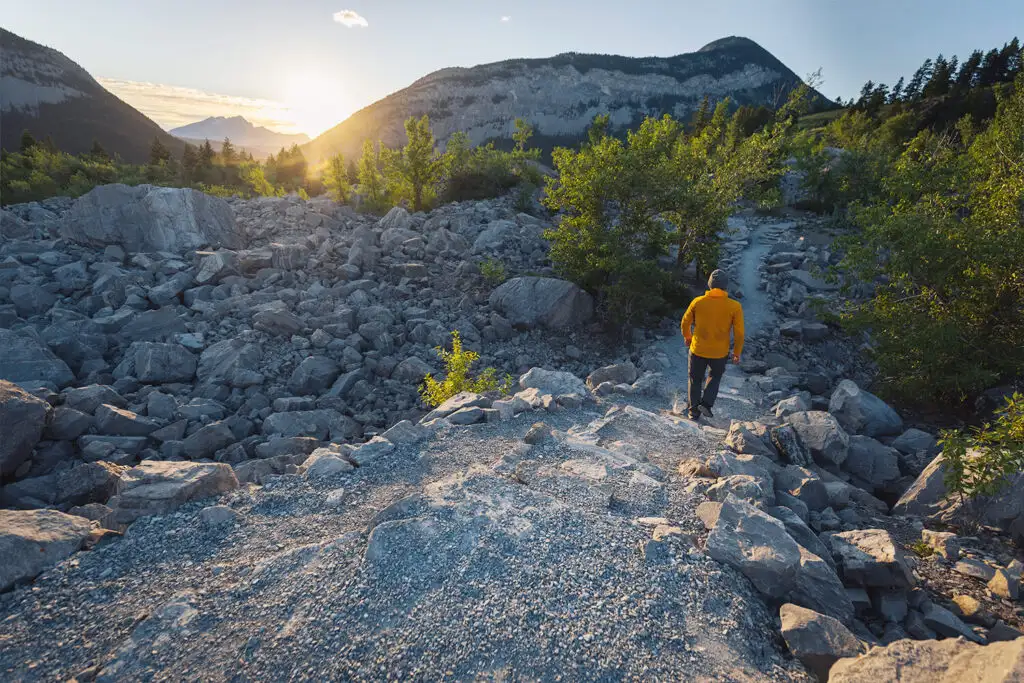
The trail turns to the west, offering views of Bluff Mountain and in the very distance Mt Tecumseh.
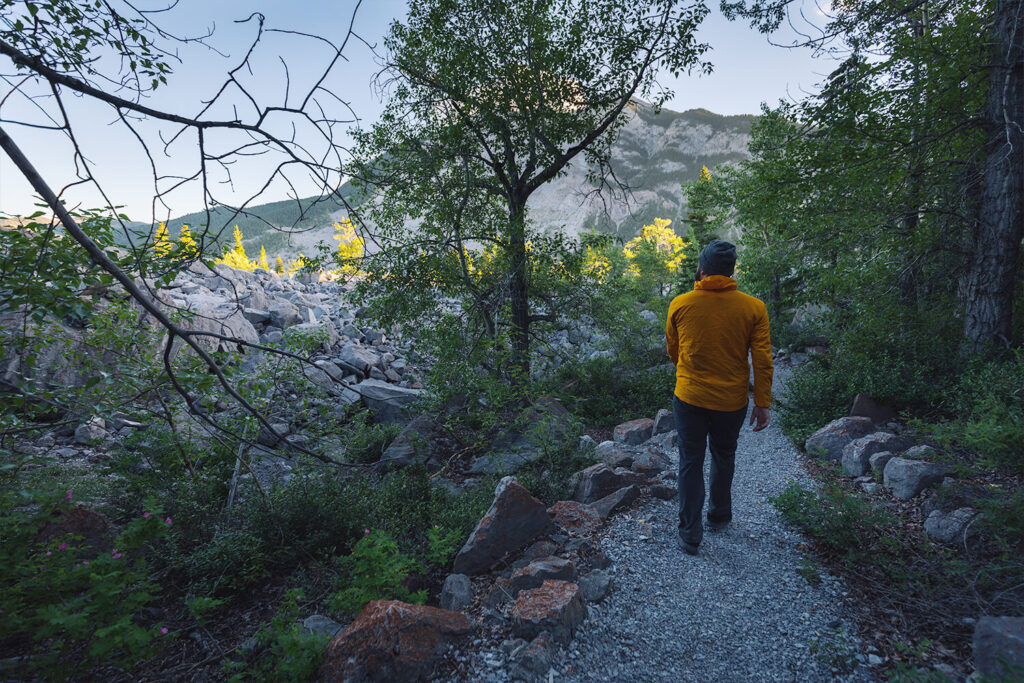
Parts of the rockslide are slowly being reclaimed by vegetation. It’ll take a long time until the entire area is reforested though.
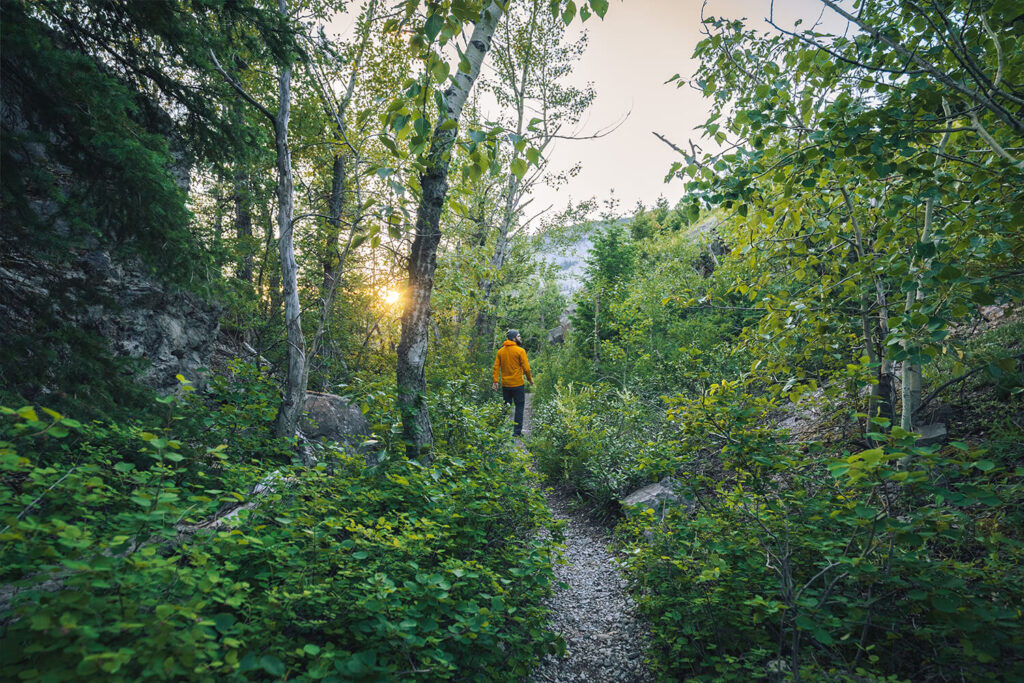
The forested section as the trail heads back up the hill is also lovely. For a section the trail follows old rail line that was completed not long before before being destroyed by the rockslide.

Back up at the other end of the parking lot, and now it’s time to visit the interpretive center.
Recommended Hiking Gear



Water is a must whenever I’m hiking, especially if the sun is going to be out. My favourite water filter I’ve used is the Katadyn BeFree 0.6L, which unlike other water filters I’ve used packs up really small and lightweight. For hikes where I know there won’t be any readily available water sources along the way, I make sure to bring my own. The Hydrapak Stow 1L bottle is my go-to, for the same reason that it’s made of a soft plastic that folds up and doesn’t take up any more extra space than necessary in my pack. Finally, Aquatabs are another great option for purifying water, with one tablet being suitable for one litre of water. I previously used the Grayl water filter while travelling internationally, and though I found its hard body more convenient for day to day use and easier to drink from, it has a little too much bulk for my fast-and-light style of hiking.



The secret to all my photos of gorgeous sunset and sunrise mountaintop views? A lot of hiking in the dark. And let me speak from personal experience when I say that the last thing that you want to happen when hiking is to be caught in the dark without a headlamp. I used the Black Diamond Spot 400 for years and it worked great – until I lost it on top of a mountain somewhere. The only downside to it was having to worry about the batteries dying, though there’s also a slightly more expensive version that has a rechargeable battery. Nowadays I’m using the Petzl Actik Core, which is a bit pricier than the more budget-friendly Black Diamond, but is also brighter, more comfortable (in my opinion), and has a hybrid power system that is rechargeable but can also take AAA batteries if needed.
You won’t see me using trekking poles on shorter hikes often – but on long hikes and backpacking trips, as well as certain scrambles, they are an absolute lifesaver. I’ve invested in a high quality ultra-lightweight pair of MSR DynaLock Ascent carbon poles which, while pricey, I don’t regret one bit. If you’re not entirely sure how much use you’re going to get out of a pair of trekking poles, the best budget-friendly option would be the Trekology Trek Z 2.0. Amazon does sell a lot of cheaper Made in China-style trekking poles for cheaper, but these usually are much much heavier and not worth buying.
All the best and most long-lasting cables and power banks I’ve ever owned have been Anker. I once had a phone cable from them that lasted me over three years of daily use! That’s why I keep an Anker PowerCore Essential 20K power bank on me. Like many people I use my phone for a lot of stuff when hiking (checking in with family, using online maps, taking photos, flying my drone) so I like to be prepared for that low battery warning by having a backup power source on me just in case.



The only socks I ever buy for myself are from Darn Tough, and I almost always make sure to wear them when hiking. After years of having no problems only wearing these comfortable and rugged socks for hikes, I accidentally wore a pair of no-name socks on a hike last year and ended up with blisters on both feet. Safe to say I’m back to sticking with the Darn Tough. And the best part? They have a lifetime guarantee, meaning that if they ever wear out you can send them back for a brand new pair. For hiking footwear I go between a pair of lightweight approach shoes for quick and dirty mountain ascents or anything involving scrambling and more heavy-duty boots for longer treks. I’ve worn a couple different versions of the lightweight but super durable Arc’teryx Konseal FL 2 approach shoes for a few years now and am very impressed with the durability. I also really like the thick toecap that keeps me protected every time I stumble into a root or large rock. For longer, tougher, or muddier treks I rely on my LOWA Camino EVO GTX, which I find insanely comfortable and made of very high quality.



I wear my Ar’teryx Gamma Lightweight Pants on every single hike I go on, and on many days when I’m not hiking. After several years of abuse they are still holding together extraordinarily well, with only a few small holes from where I’ve fallen down and some slight stains from being repeatedly coated with mud. They’re lightweight, breathable, and super comfortable. For lightweight and breathable hiking tops I’m a big fan of both the Patagonia Capilene Shirt and the MEC Core Shirt. My Arc’teryx Squamish Hoody shows up in a lot of my photos. It’s super lightweight and packable, and does a great job of cutting the wind while also being pretty breathable. I also have an Arc’teryx Atom Hoody and Arc’teryx Beta LT that I pull out for cooler or wetter conditions.
I hope you enjoyed this guide to hiking the Frank Slide Trail in the Crowsnest Pass! Feel free to leave any questions in the comment section below or to contact me directly via social media.
